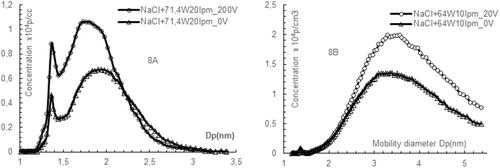 ?Mathematical formulae have been encoded as MathML and are displayed in this HTML version using MathJax in order to improve their display. Uncheck the box to turn MathJax off. This feature requires Javascript. Click on a formula to zoom.
?Mathematical formulae have been encoded as MathML and are displayed in this HTML version using MathJax in order to improve their display. Uncheck the box to turn MathJax off. This feature requires Javascript. Click on a formula to zoom.Abstract
Sub 5 nm particles are more and more detected, measured and monitored since few years. They appear in many fields including combustion, atmosphere, automotive industry, filtration, … They are studied because of the development during the last decades, of their different instrumentation in terms of generation, classification, detection and counting (CPCs, PSMs, DMAs, and mass spectrometers). These instruments need to be calibrated with stable sources of particles down to 1 nm. Electrospray source plays a major role in the generation of singly charged ions, soluble in water or alcohols from 1 to 1.8 nm. Unfortunately, clusters larger than 1.8 nm produced with electrospray atomization are multi charged. Charge reduction with a neutralizer or bipolar electrospray source are then required to bring their electrical charge to unity.
Heated wires have shown their ability to produce non-soluble hydrophobic singly self-charged particles from 1.3 nm to 20 nm without any external device to bring their electrical charge to unity. The heated wire method have been widely used with noble and inert gases (N2, He, Ar) to produce clean and pure nanoparticles. The present work focuses on the generation in air of hydrophobic nickel chrome oxides and hydrophilic and water-soluble chlorides particles. The study focuses on the generation of sub 5 nm. A high flow and high resolution DMA is used for this purpose. The method produces concentrations up to 5 104 p/cc after classification with a DMA. The generation presents a long-term high stability in terms of concentration.
The losses and rate of agglomeration inside the chamber and in the DMA are not taken into account. The results given in the article are the distributions available after classification and ready to be used.
Copyright © 2022 University Paris Est Creteil
Editor:
Introduction
Coulier (Citation1875) has reported the production of condensation nuclei with heated wires for the first time in 1875. Many other investigators have used heated wires or glowing wires to study their nature or as a source of particles: Gwilym (Citation1903), Nolan and Kennan (Citation1949), O’Connor and Roddy (Citation1966), Vonnegut (Citation1953), Liu et al. (Citation1975). Later the method has been updated as a source of clean and pure nanoparticles in noble gases (Fernandez de la Mora, Liedtke, and Schmidt-Ott Citation2003; Peineke, Attoui, and Schmidt-Ott Citation2006; Peineke et al. Citation2009; Boies et al. Citation2011; Khan et al. Citation2014; Fomenko et al. Citation2021). The development of CPCs sensitive to sub 2 nm particles and atmospheric pressure mass spectrometers, opened another application field to the wire generator method. Indeed the wire generator is widely used for the calibration and characterization of the particle size magnifier (PSM), butanol and water CPCs and mass spectrometer in the sub 3 nm range (Liu et al. Citation2021; Kong et al. Citation2021; Picard, Attoui, and Sellegri Citation2019; Attoui Citation2018; Sharma et al. Citation2021; Hering et al. Citation2017; Kangasluoma et al. Citation2013, Citation2014; Kangasluoma, Junnine, and Attoui Citation2017).
The present work focuses on the characterization of heated nickel chromium wires in air for the production of sub 5 nm oxides particles in the first part. The second part of the task is devoted to the generation of soluble singly self-charged particles (NaCl and KCl) with coated NiCr thick wires. To prevent agglomeration of the particles, high flowrates of the carrier gas are used. Flow rates up to 30 lpm of dry clean air are used in this study. The choice of air is deemed by the price of the carrier gas for long-term measurements when noble gases (without oxygen) are not vital. Nickel chromium wire is chosen because it can withstand the oxidation and breakage induced by the oxygen of the air at high temperatures.
The goal of the present task is not a comparison between the experimental results and the theory based on the evaporation rate of the wire. The goal is to show that the wire generator produces sub 5 nm oxide NiCr particles when atmospheric compressed dry filtered air is used as a carrier gas. The electrical heating power in the wire parameter is used rather than the temperature. The temperature measurement is not easy to reproduce. Indeed the temperature of the wire is not uniform along its length due to conduction losses into the electrodes (Langmuir, MacLane, and Blodgett Citation1930). On the other hand, the flow around the wire is parabolic. This leads to a non-uniform cooling of the wire surface along its length. The other reason is that the reproducibility of the experimental results based on the color of the heated wire and the heating power are sufficient for the use of the generator during many hours.
The method based on the color of the hot wire gives a very good reproducibility in terms of mobility distributions and concentrations when the different parameters are kept the same. The parameters are the air flowrate, the diameter and the length of the wire. This makes the generator easy to use. The article gives the key conditions for the production of sub 5 nm oxide self-charged particles in air.
The study ignores the basic phenomena and theory of the production of clusters with condensation of vapors from heated wires. The reader can find more information on the theory in Ghosh et al. (Citation2020, Citation2021), for example. The study ignores the zero charged (or neutral) particle produced by the generator. Indeed, the zero charged particles need a charging method (radioactive source) to detect them. This will make the generator far from ‘simple, cost effective and ‘easy to use’’.
Hot wire generation of hydrophobic and non-soluble nanoparticles method uses evaporation of vapor material from the wire surface. The method is clean because the hottest point of the generator is the wire itself. The temperature of the produced vapors decreases drastically as soon as these vapors leave the surface of the wire. The vapors nucleate in the gas stream to form particles (evaporation condensation). High flow rates help to prevent their agglomeration and keep them single. On the other hand, high flowrates increase their transmission by minimizing their deposition losses by diffusion. Large fraction of self singly charged particles are produced with this method. The fact that the particles are self and singly charged is of special interest. Indeed, the particles are directly usable without neutralizer nor charger. Coated wires with NaCl and KCl are heated-up with the same way in the same device to produce hydrophilic and water soluble positive and negative nanoparticles self singly charged in the sub 5 nm range.
Method and experimental set up
shows the experimental set up used to characterize the generator. Four arms high vacuum stainless steel cross (NW40) is used as a chamber (Peineke, Attoui, and Schmidt-Ott Citation2006; Peineke et al. Citation2009). The heated wire is attached at the two ends of a high current feedthrough inside the stainless steel cross. Two opposite arms of the cross are devoted to the inlet and the outlet of the carrier gas stream. The remaining flange is equipped with a viewport for a visual access to the hot wire. 15 Volts 40 Amp DC power supply provides the electrical power W (W = U*I) to heat up the wire. A bipolar floating FUG high voltage power supply can supply the bias of the wire, up to 300 Volts. The stainless steel cross is electrically grounded. The DC power supply used to heat up the wire can be floating or referenced to the ground.
Filtered and dried compressed laboratory air is used as a carrier gas with a flow rate as high as 30 liters per minute (lpm) inside the wire chamber. 6 lpm of air are cooled before they enter in a high resolution DMA in closed loop. The excess flow is purged through a filter outside of the lab. The cooling section before the DMA is made of 10 cm long and 4 cm inner diameter copper tube surrounded by a water jacket. Because the CPCs present poor detection efficiency in the sub 5 nm, an aerosol electrometer is used in the study as detector. A homemade Faraday cage coupled to a Keithley (6514 model) electrometer measures the concentration of the particles selected by the DMA. The 6514 Model is sensitive to 100 atto Amps (0,1 femto Amp). A fan is installed on the top of the stainless steel cross to help to cool down the cross itself. A TSI mass flowmeter monitors the aerosol flowrate in the Faraday cup.
Coils of four or five circles from ten centimeters length wire constitute the heating element. The temperature of the wire is estimated by its color through the viewport of the cross. This primitive method helps to reproduce the experimental conditions for different diameters of the wires and different flowrates of air. The electrical power W in the wire is less precise method because the temperature depends on the flowrate in the chamber. The color of the wire monitored by eye helps the user to have an approximate status of the thermal conditions of the wire. The temperature of the wire is not measured nor needed to run the generator. The heating power in the wire and the flowrates are the parameters used to characterize the generator in the sub 5 nm range.
The nickel chromium (80% Ni & 20% Cr) can handle temperatures up to 1 200 °C in dry air. Its melting point is around 1400 °C. It has a resistivity at room temperature ranging from 1.1 10−6 to 1.5 10−6 Ωm. Three different wire diameters have been tested in this study for the production of metal oxides: 0.3; 0.4 and 0.6 mm. Large diameters need high electrical currents. Large resistances and high temperatures are given by thin wires for a given power W of the power supply through the Joule formula: Q = RI2. On the other hand, thin wires are more fragile and risk breaking faster than the thick ones when the temperature is close to the melting point under the puff of the carrier gas.
A high flow and high resolution half-mini type DMA (Fernandez de la Mora Citation2017) in closed sheath loop is used in this study. The constant sheath flowrate is not measured. It is estimated to be around 300 (three hundreds) liters per minute. This relatively low flow is needed to detect particles as large as 5 nm. The DMA uses 6 lpm equal polydisperse and monodisperse aerosol flowrates. The maximum voltage of this DMA is limited to 5 kV, which corresponds to 6 nm diameter for the sheath flow value used in the study. Applied kilovolts bipolar source ((+/- 5 kV) is coupled to the DMA. The voltage of the DMA is scanned with a logarithmic ramp from 0 to 4.5 kilovolts in positive or negative mode.
The monomer of tetra heptyl ammonium bromide (THABr) is used to determine the calibration factor k of the DMA (Ude and Fernández De La Mora Citation2005). The factor k relates the particle mobility Z to the measured voltage V.
(1)
(1)
k = constant if Q is constant.
Zs is the mobility of monomer of THABr (0,970 cm2/Vs), Vs is the voltage of the DMA corresponding to the maximum of peak of the monomer. The voltage is turned to the mobility through k = V.Z; V is the voltage required in the DMA to select particles of mobility Z.
The mobility distribution measured by the DMA is converted to mobility diameter using the Stockes-Cunningham equation (Friedlander Citation2000)
(2)
(2)
(3)
(3)
(4)
(4)
Results and discussion
The wire generator has been used during more than 2 years with lab air for different tasks and measurements in the sub 5 nm range (filtration efficiency measurement, detection efficiency of CPCs and PSM, calibration of mass spectrometer). Long-term measurements have shown excellent stability of the generation (size and concentration). The size distributions given are average levels of at least five scans taken during one hour for each distribution. The size distributions are measured with dry and filtered lab compressed air. The RH of the lab compressed air after drying is between 0 and 3%. There was no difference between summer and winter results.
Flowrates larger than 6 lpm around the wire are needed to minimize the losses in the cross and tubes before the DMA itself. Large flowtrates offer the benefit of dilution of the vapors produced by the wire to prevent nucleation and agglomaration. The residence time in the chamber and in the DMA is around 100 milliseconds for 6 lpm. The electrical power W and the shining color of the nickel chromium wire through the window of the cross are the two parameters available for the user to control and reproduce the experimental conditions and results. The heating power W in Watts is the product of the voltage and the current of the power supply applied to the wire. The different wires used in this study are ∼ 10 cm length wire rolled in 4 or 5 turns. There are 2 ways to get low temperatures on the surface of the wires. The first one is a low resistive electrical power W applied to the wire with low flow rate (below 10 lpm). The second way is a higher power W with high flow rates (up to 30 lpm).
The diffusion losses in the tubes are not taken into account in the presented results. The study gives the raw distributions after the DMA without any correction. The study focuses on the real available particles that will be used by the user after their selection by the DMA. The study does not give a care to the original concentrations and sizes before the DMA. Only transmitted particles in the tubes and in the DMA are detected and shown. Flowrates up to 30 lpm air are studied to minimize losses and agglomaration rate.
Positive nickel chrome oxides particles
gives examples of size distributions in positive mode with 0.5 mm diameter wire in 6 liters per minute air, at different electrical powers W (or temperatures). Very small particles ∼1.4 nm mobility diameter (∼1.1 nm mass diameter) start to emerge at low temperatures (reddish colored wire).
Three single and sharp peaks (1.47; 1.57 and 1.59 nm mobility diameters) emerge in the sub 2 nm range () when the electrical power is between 50 and 65 watts. The shapes and diameters of the peaks of (49 Watts) are characteristic of single molecules or ions as seen with other wires in noble gases (Kangasluoma et al. Citation2013; Domaschke, Lübbert, and Peukert Citation2019) in the sub 2 nm range with a mass spectromer.
Figure 3. Effect of the temperature on the size distributions of positive singly self-charged particles generated by a heated wire (0.5 mm diameter) in 6 lpm air flowrate.
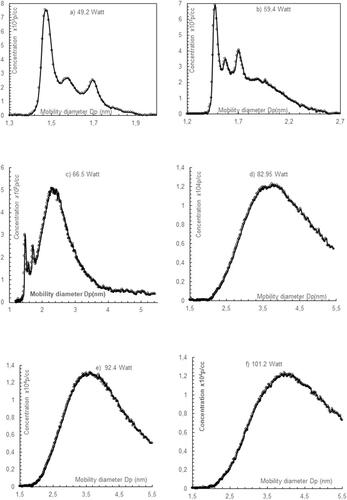
These peaks show significant difference with sub 2 nm singly charged ions produced with electrospray source (Ude and Fernández De La Mora Citation2005). Indeed, the tails of their distributions are long and mix before they drop to zero.
The clean well-defined peaks disappear completely () at higher temperatures of the wire (higher values of the electrical power W). High temperatures of the wire produce high concentrations of vapors, which consequently produce a continuum of large diameters ().
Indeed the sharp peaks given by low temperatures of the wire ((49,W) in are totally absent in where the heating electrical power is 101 watts at the same air flowrate (6 lpm). A shift of the distribution from small to large particles is clearly seen for example in . The distributions in starts at 2 nm. On the other hand larger particles with higher concentrations appear on the right of . The electrical resistive power W varies from 50 to 100 Watt with constant flowrate of 6 lpm lab clean air.
High concentrations of particles per cubic centimeter produced by the generator appear at higher temperatures. The concentrations of selected self-charged particles by the DMA are however never higher than 5104 particles per cubic centimeter. It is worth remembering that the transmission of the DMA is around 10% in this range of particles diameters (Cai et al. Citation2018).
High electrical powers W are needed to heat up the wire when flowrates are higher than 6 lpm. Indeed the lab air enters in the cross at room temperature which induces a non-negligible cooling of the wire. The cooling generated by high flows acts on the resistivity of the wire. As a consequence of that the resistance of the wire and the temperature of the wire drop. Higher power W is then needed to heat up the wire to the correct temperature value (or color). That explains the need of a high current power supply (40 Ampères; 15 Volts in this study). The power supply is not exceptionally expensive (∼250 Euros).
Negative nickel chrome oxides particles
The heated wire produces positive and negative particles at the same time. To see or detect the negative ones, one has just to switch the polarity of the power supply applied to the DMA. The behavior, in terms of size and concentration, of the particles generated from the heated wire in negative mode is more or less the same than the one in positive mode. Small particles emerge at low temperatures of the wire and large diameters at high temperatures.
illustrates the case where high flowrates of clean dry lab air are used with different values of the heating power W. High temperatures are needed to produce negative particles compared to the production of positive particles. High flowrates helps to keep the temperature of the wire low for the generation of small diameters (sub 2 nm for example). That helps at the same time to increase the transmission in the complicated geometry of the cross (Megeyri, Kohut, and Geretovsky Citation2021).
Figure 4. Effect of the temperature on the size distributions of negative singly self-charged particles generated by a heated wire (0.5 mm diameter) in 25 lpm air flowrate.
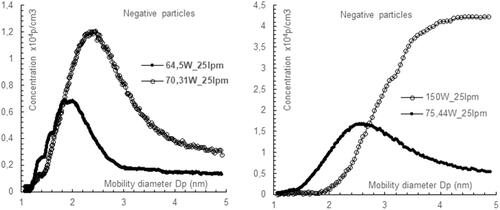
It can be seen clearly in that the distributions of small particle centered on 2 nm emerge at higher flowrates with low electrical power (or temperature) of the wire. The maximums of the distributions in shift barely from 2 nm to 2.4 nm when the heating power in the wire increases by 5 watts.
One can see that the distributions of negative particles are wider, compared to what have been seen in the case of positive particles in the same conditions. At the same time, the concentrations are higher and large particles start to emerge on the right of the distributions. These observations show that when the temperature of the wire is high enough the concentration of large particles increases even with high flow of the carrier gas despite the dilution of the vapor molecules.
The temperature and the flowrate of the carrier gas are the parameters that the user can play with to produce the size distributions of particles according to his needs. The concentrations of negative particles are always lower than the positive ones for the same conditions (diameter of the wire, temperature and airflow rate). On the other hand, it has never been possible to observe sharp negative peaks of ions whichever the temperatures of the wire and the flowrates. It seems that the nickel chrome wire cannot produce self-charged negative ions in air.
The concentrations of positive and negative particles produced by the same hot wire in the same conditions (flowrate and heating power) are not symmetric for unknown reasons. The concentrations of negative are always lower than the concentrations of positive particles. To have enough (more than few thousands) negative particles one has to use higher electrical power in the wire and higher flowrate. The reason could be that electrons are used to charge negatively the particles. The losses of electrons are too high because of their high mobility. Increasing the heating power helps to increase the concentration of electrons produced by thermionic emission from the wire.
Nickel chromium wires coated with sodium and potassium chloride particles
Hygroscopic and soluble particles in the sub 5 nm range diameters are needed for the calibration of, CPCs, PSMs, growth factor measurements in hygroscopic tandem DMAs (HTDMAs) and heterogeneous nucleation studies. In this work, the wire generator uses coated wires to generate chloride hygroscopic and water-soluble singly self-charged particles.
Lodge and Tufts (Citation1955) and Swift (Citation1967) have used wires coated with water-soluble salts to produce large soluble and hygroscopic particles. The present study focuses on the generation of sub 5 nm salt particles using the hot wire generator with thick wire coated with sodium chloride (NaCl) and potassium chloride (KCl). The wire mounted on the thick electrodes is immersed during few seconds in saturated water solution of sodium or potassium chloride. Enough salt deposits on the wire, the tips of the electrodes and in the hexagonal socket head screws after drying by evaporation the water at room temperature. shows the deposited salts on the metallic parts of the feedthrough and the wire itself.
Figure 5. Views of the deposited salt on the thick electrodes of the high current feedthrough of the cross.
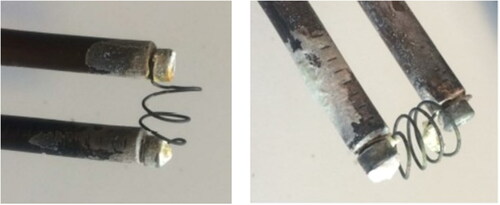
Thick wires of 1.2 mm diameter are used at low temperatures to prevent metal oxide particles production. The resistance of the wires is, in this case, much lower than the ones of the wires used to produce metal oxides particles (0.3; 0.4 and 0.5 mm). The main goal is to heat up the coated wire and produce salt particles without reaching the trigger point of metallic particles generation. Through the window, the user can see that the wire is ‘dark’ and not shiny at all. The wire color confirms that the temperature is too low to evaporate any metallic material from the surface of the wire itself.
The deposited salts on the hot parts of the generator evaporates at lower temperatures than the wire itself because they have lower melting points than the one of the nickel chromium: 770 °C for the potassium chloride and 801 °C for the sodium chloride. The vapors from the salts produce particles by condensation as soon as they leave the hot metal parts. Positive (NaCl+) and negative (NaCl-) sodium chloride particle distributions are shown in . The particles are singly self-charged. The gives examples of size distributions of positive (KCl+) and negative (KCL-) potassium chloride. The behavior of the generation of salt particles is the same than the generation of the particles produced with a ‘naked’ NiCr wire.
Figure 6. Positive and negative sodium chloride (NaCl+ and NaCl-) size distributions particles at two different temperatures and air flowrate.
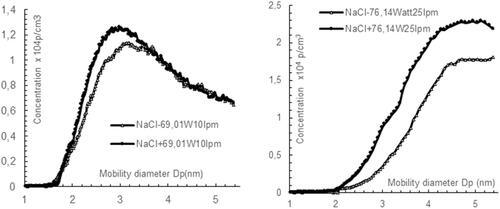
Figure 7. Positive and negative sodium chloride (KCl) size distributions particles at two different temperatures and air flowrates.
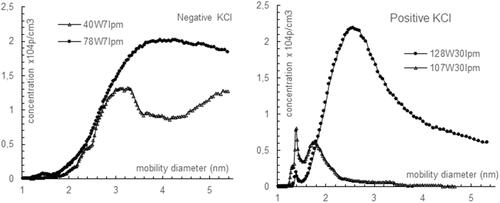
The sharp peaks seen (1.37 nm) in appears only with high flowrate and large heating power (30 lpm; 107 & 128 Watts). It shows that large flowrates are needed to minimize the losses inside the chamber and to limit drastically the agglomeration rate. That helps the small clusters to survive until their selection and detection at the outlet of the DMA. The transmission inside high flow DMAs is known to be poor (around 10%) for sub 3 nm particles (Attoui and Fernandez de la Mora Citation2016; Kangasluoma et al. Citation2016; Cai et al. Citation2018).
Effect of the electrical voltage bias on the concentration
The maximum concentrations of particles generated by the present method in the sub 5 nm is limited to few tens of thousands per cubic centimeter (∼ 5 104 p/cm3). In many applications, higher concentrations are needed because the losses in the lines and instruments are very large in this size range. A method to increase this concentration without any external charging system is then very welcome. Since the particles are electrically charged, an electrical field is used in this study to pull more materiel from the wire and its hottest surrounding area. The method consists to bias the wire against the grounded cross with a DC voltage of the right polarity as shown in the experimental set up ().
The shows an example of the results with 200 V bias in the case of small diameters (below 2.5 nm). shows that 30 Volts are enough to increase the concentration of large particles, between 2 and 5 nm. The concentration can rise even for the small diameters by a factor of 2.
Stability over time
The wire generator has shown in the pass its ability to produce stable concentration during many hours (Kangasluoma, Junnine, and Attoui Citation2017; Peineke, Attoui, and Schmidt-Ott Citation2006). shows an example of the evolution of the concentration during many hours for three different diameters in the sub 3 nm. The concentration is recorded during 2 min every 3 min during a whole day for each diameter given in .
Conclusion
In this work, a hot wire generator of singly self-charged particles, with clean dry laboratory compressed air is characterized in the sub 5 nm range. The study focuses on the self-charged positive and negative particles after their selection by a high resolution and high flowrate DMA. Flowrates up to 30 lpm dry clean air in the generator are used to minimize the losses and agglomaration rate.
Nickel chromium (NiCr) wire is used, thanks to its oxidation and hot corrosion resistances at high temperatures. Positive and negative self singly charged oxide particles are produced down to 1,3 nm mobility diameter. The same method or generator is used to generate hydrophilic and water soluble chloride particles with coated NiCr wires. There is no need of an external charging device unlike the electro atomization or evaporation condensation oven based methods, in the sub 5 nm range. The maximum of the concentrations of particles produced by the generator are limited to 5 104 p/cm3 after classification. This concentration is large enough for the detection efficiency measurements of condensation particle counters, particle size magnifiers and mass spectrometers calibration.
The concentrations of positive particles are higher than the concentrations of negative particles in all cases as seen previously by different authors with noble gases. A voltage bias of the wire against the grounded cross, can be used to increase the concentration especially for the smallest diameters where the diffusion losses are very pronounced. The minimum flowrate in the generator is 6 liters per minute to minimize the diffusion losses and the agglomeration rate of the smallest particles. Flowrates up to 30 lpm tested in this work give large amount of particles even in the small size range.
Acknowledgments
I wish to acknowledge my indebtedness and sincere thanks to Prof. Dr. and President Denis Boulaud for his kind encouragement and valuable daily help during the last years.
Disclosure statement
No potential conflict of interest was reported by the author(s).
References
- Attoui, M. 2018. Activation of sub 2 nm singly charged particles with butanol vapors in a boosted 3776 TSI CPC. J. Aerosol. Sci. 126:47–57. doi:10.1016/j.jaerosci.2018.08.005.
- Attoui, M., and J. Fernandez de la Mora. 2016. Flow driven transmission of charged particles against an axial field in antistatic tubes at the sample outlet of DMA. J. Aerosol Sci. 100:91–6. doi:10.1016/j.jaerosci.2016.06.002.
- Boies, A., M. Pingyan Lei, S. Calder, W. G. Shin, and S. L. Girshick. 2011. Hot-wire synthesis of gold nanoparticles. Aerosol Sci. Technol. 45 (5):654–63. doi:10.1080/02786826.2010.551145.
- Cai, R., M. Attoui, J. Jiang, F. Korhonen, J. Jiming Hao, T. Tuukka Petäjä, and J. Kangasluoma. 2018. Characterization of a high-resolution supercritical differential mobility analyzer at reduced flow rates. Aerosol Sci. Technol. 52 (11):1332–43. doi:10.1080/02786826.2018.1520964.
- Coulier, P. J. 1875. Note sur une nouvelle propriété de l’air. J. Pharm. Chim. 22:254.
- Domaschke, M., C. Lübbert, and W. Peukert. 2019. Analysis of ultrafine metal oxide particles in aerosols using mobility-resolved time-of- flight mass spectrometry. J. Aerosol Sci. 137:105438. doi:10.1016/j.jaerosci.2019.105438.
- Fernandez de la Mora, J. 2017. Expanded flow rate range of high-resolution nano DMAs via improved sample flow injection at the aerosol inlet slit. J. Aerosol Sci. 113:265–75. doi:10.1016/j.jaerosci.2017.07.020.
- Fernandez de la Mora, J., and C. Barrios-Collado. 2017. A bipolar electrospray source of singly charged clusters of precisely controlled composition. Aerosol Sci. Technol. 51 (6):778–86. doi:10.1080/02786826.2017.1302070.
- Fernandez de la Mora, J., L. Liedtke, and A. Schmidt-Ott. 2003. Mass and size determination of nanometer particles by means of mobility analysis and focused impaction. J. Aerosol Sci. 34:78–98.
- Fomenko, E., I. Altman, L. Boskovic, and I. E. Agranovski. 2021. Nanoparticle generation in glowing wire generator: insight into nucleation peculiarities. Materials. 14 (24):7775. doi:10.3390/ma14247775.
- Friedlander, S. K. 2000. Smoke dust and haze: Fundamentals of aerosol dynamics. New York: Oxford University Press/New York: John Wiley & Sons.
- Ghosh, K., S. N. Tripathi, M. Joshi, Y. S. Mayya, A. Khan, and B. K. Sapra. 2020. Particle formation from vapors emitted from glowing wires: theory and experiments. Aerosol Sci. Technol. 54 (3):243–61. doi:10.1080/02786826.2019.1688758.
- Ghosh, K., S. N. Tripathi, M. Joshi, Y. S. Mayya, A. Khan, and B. K. Sapra. 2021. Effect of charge on aerosol microphysics of particles emitted from a hot wire generator: theory and experiments. Aerosol Sci. Technol. 55 (9):1084–98. doi:10.1080/02786826.2021.1931011.
- Gwilym, O. 1903. On the condensation nuclei produced in air and hydrogen by heating a platinum wire. Philos Mag Ser. 6 (33):306–15. doi:10.1080/14786440309463021.
- Hering, S. V., G. S. Lewis, S. R. Spielman, A. Eiguren-Fernandez, N. M. Kreisberg, C. Kuang, and M. Attoui. 2017. Detection near 1 nm with a laminar-flow, water based condensation particle counter. Aerosol Sci. Technol. 51 (3):354–62. doi:10.1080/02786826.2016.1262531.
- Kangasluoma, J., L. Ahonen, M. Attoui, H. Vuollekoski, M. Kulmala, and T. Petäjä. 2014. Sub 3 nm particle detection with commercial TSI 3772 and Airmodus A20 fine condensation particle counters. Aerosol Sci. Technol. 40 (8):674–81.
- Kangasluoma, J., M. Attoui, F. Korhonen, L. Ahonen, E. Siivola, and T. Petäjä. 2016. Characterization of a Herrmann-type high resolution DMA. Aerosol Sci. Technol. 50 (3):222–9. doi:10.1080/02786826.2016.1142065.
- Kangasluoma, J. H. Junnine, and M. Attoui. 2017. Method and arrangement for optimization or calibration of particle detector. International Patent WO 2017/162925 A1.
- Kangasluoma, J., H. Junninen, K. Lehtipalo, J. Mikkila, J. Vanhanen, M. Attoui, M. Sipila, D. Worsnop, M. Kulmala, and T. Petaja. 2013. Remarks on ion generation for CPC detection efficiency studies in Sub-3-nm size range. Aerosol Sci. Technol. 47 (5):556–63. doi:10.1080/02786826.2013.773393.
- Khan, A., P. Modak, M. Joshi, P. Khandare, A. Koli, A. Gupta, S. Anand, and B. K. Sapra. 2014. Generation of high-concentration nanoparticles using glowing wire technique. J. Nanoparticle Res. 16:2776. doi:10.1007/s11051-014-2776-5.
- Kong, W., S. Amanatidis, H. Mai, C. Kim, C. Schulze, B. Huang, Y. Lewis, G. S. Hering, S. V. Seinfeld, J. H. Richard, et al. 2021. The nano scaning electrical mobility spectrometer (nSMPS) and its application to size distribution measurements of 1.5–25 nm particles. Atmos. Meas. Tech. 14 (8):5429–45. doi:10.5194/amt-2021-62.
- Langmuir, I., S. MacLane, and K. B. Blodgett. 1930. The effect of end losses on the characteristics of filaments of tungsten and other materials. Phys. Rev. 35 (5):478–503. doi:10.1103/Phys.Rev.35.478.
- Liu, Y., M. Attoui, Y. Li, J. Chen, Q. Li, and L. Wang. 2021. Characterization of a Kanomax fast condensation particle counter in the sub-10 nm range. J. Aerosol Sci. 155:105772. doi:10.1016/j.jaerosci.2021.105772.
- Liu, B. Y. H., D. Y. H. Pui, A. W. Hogan, and T. A. Rich. 1975. Calibration of the Pollak counter with monodisperse aerosols. J. Appl. Meteor. 14 (1):46–51. doi:10.1175/1520-0450(1975)014<0046:COTPCW>2.0.CO;2.
- Lodge, J. P., and B. J. Tufts. 1955. An electron microscope study of sodium chloride particles as uses in aerosol generation. J. Colloid Sci 10 (3):256–62. doi:10.1016/0095-8522(55)90038-6.
- Megeyri, D. A. Kohut, and Z. Geretovsky. 2021. Effect of flow geometry on the nanoparticle output of a spark discharge generator. J. Aerosol Sci. 154:105758. http://www.elsevier.com/locate/jaerosci
- Nolan, P. J., and E. L. Kennan. 1949. Condensation nuclei from hot platinum: size, coagulation coefficient and charge-distribution. Proc. Royal Irish Acad., Dublin 52A13 (1949):171–90.
- O’Connor, T. C., and A. F. Roddy. 1966. The production of condensation nuclei by heated wires. J. Recherches Atmosphériques N. 2 (3):239–44.
- Peineke, C., M. Attoui, R. Robles, A. C. Reber, S. N. Khanna, and A. Schmidt-Ott. 2009. Production of equal sized atomic clusters by a hot wire. J. Aerosol Sci. 40 (5):423–30. doi:10.1016/j.jaerosci.2008.12.008.
- Peineke, C., M. Attoui, and A. Schmidt-Ott. 2006. Using a glowing wire generator for production of charged, uniformly sized nanoparticles at high concentrations. J. Aerosol Sci. 37 (12):1651–61. doi:10.1016/j.jaerosci.2006.06.006.
- Picard, D., M. Attoui, and K. Sellegri. 2019. B3010: a boosted TSI 3010 condensation particle counter for airborne studies. Atmos. Meas. Tech. 12 (4):2531–43. doi:10.5194/amt-12-2531-2019.
- Sharma, G., M. Wang, M. Attoui, X. You, and P. Biswas. 2021. Measurement of sub-3 nm flame-generated particles using butanol CPCs in boosted conditions. Aerosol Sci. Technol. 55 (7):1–13. doi:10.1080/02786826.2021.1896675.
- Swift, D. L. 1967. A study of the size and monodispersity of aerosols produced in a Sinclair Lamer generator. Ann. Occup. Hyg. 10:337–48.
- Ude, S., and J. Fernández De La Mora. 2005. Molecular monodisperse mobility and mass standards from electrosprays of tetra-alkyl ammonium halides. J. Aerosol Sci. 36 (10):1224–37. doi:10.1016/j.jaerosci.2005.02.009.
- Vonnegut, B. 1953. Effect of halogens on the production of condensation nuclei by a heated platinum wire. Science. 117 (3031):108–9. doi:10.1126/science.117.3031.108.



